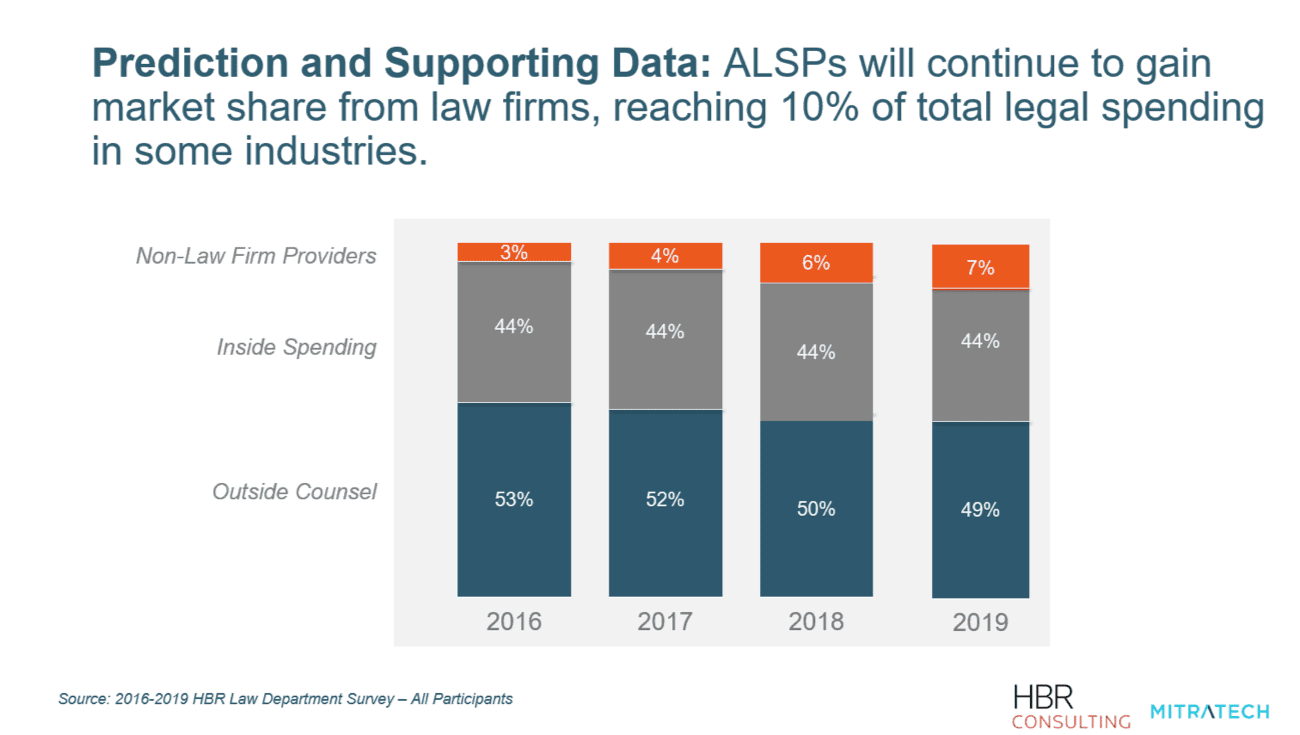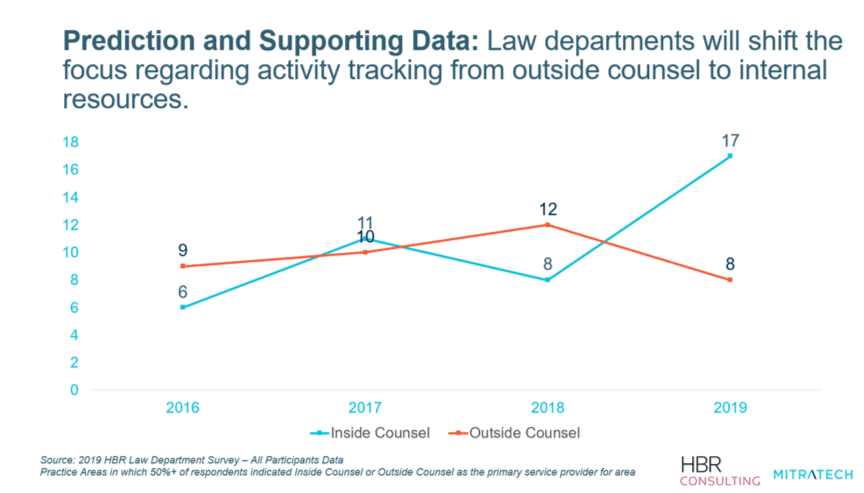20/20 for 2020: Bold Legal Ops Predictions for the New Year
It’s that season again; not just for celebrating a new year, but for making predictions about it…and beyond. Especially when it comes to what may lie ahead in Legal Ops, data privacy, and information governance.
For 2020, Mitratech and HBR Consulting went to a variety of Legal Ops leaders and pundits in search of their forecasts, with supporting data thrown in to back up their prognostications. Beyond the sheer fun of future-gazing, there’s obviously serious purpose at work here, as their outlooks might give us all better insights to apply to Legal Operations strategies over the next twelve months, or even further down the road.
Please note that our Bold Predictions webinar is rich with even greater detail and survey results. In this post, we’re toplining the 2020 trends that the webinar delves into, touching on data and analytics, data privacy, ALSPs, diversity, automation, AI, and the future of Legal Ops trailblazing and growth.
Ready? Let’s warm up the crystal ball and dive in…

You’ll be able to make better predictions with your data
Data, no matter which team you’re on, exists in vast amounts within a corporation, and as Brian McGovern, General Manager – Workflow Solutions at Mitratech contends, “data sources and volume will continue to grow, exponentially.” That’ll allow businesses and internal organizations to make better, more informed choices that give them a competitive advantage over competition.
The use of analytics tools in legal departments is expanding into a “core stack” of solutions delivering on more than just the analysis of matter and spend data. By 2021, an estimated 78% of law departments will be using analytical tools for ELM, according to the 2019 HBR Law Department Survey.

More work will go in-house
Since it originated as a means of mitigating costs and inefficiencies in the legal department, Legal Operations have kept savings and performance top of mind. Hewlett Packard Enterprises’ Chief Operating Officer of Legal and Administrative Affairs, Molly Tynan Perry, thus predicts that “more companies will look to analyze internal resource time and activities to drive greater visibility into how work is being performed in-house…[this] will lead to greater opportunity to reconsider how to streamline internal work.”
Outside spend in a tailspin? External legal spend by large and mid-sized companies fell 24% in 2019, according to.CLOC.
Every few years, we see a shift from inside to outside counsel spend, and then vice-versa. In the past year, this has trended significantly toward far more organizations bringing work in-house, versus those using outside counsel.
Based on Molly’s insights and what the market is broadly demonstrating? It’s safe to assume that bringing more work to in-house teams will become a big consideration for more legal departments in 2020.

Artificial intelligence and machine learning are rising (and rising…)
Emergent tech is not slowing down in the legal industry. Providers and their customers are creating more and more opportunities for AI and machine learning software to be put to use. George Chiu, Director ITG Law, Compliance, Business Ethics and External Affairs at Prudential posits these technologies “will be fundamental for Legal Operations just like Matter Management and e-Billing” currently are, and will be considered more “than a competitive advantage.”
Data shows that while approximately 9% of law departments have currently implemented AI features into their solution sets, these features will be expected by more than 50% of the market by 2021. Companies will need to be proactive in understanding the underlying needs for these tools, and how this will help their businesses in the long run.
[bctt tweet=”AI and machine learning features will be expected by more than 50% of the legal tech market by 2021.” via=”no”]

Diversity initiatives will continue
Mike Russell, Lead Leader – Legal Operations at Ingersoll Rand, puts it simply: “Ongoing diversity efforts start to pay off in 2020 – socially conscious organizations will only work with truly diverse providers.”
It’s not a new concept, as there’s been a social push to do more on this front and increase diversity awareness among the companies, law firms, and vendors involved in the legal ecosystem.
This is already impacting what information and questions are included in RFPs, firm selection, existing firm staffing, engagement with minority and/or women-owned firms, and analyses leading to reduced spending with firms that don’t align with a company’s diversity criteria.
“Socially conscious organizations will only work with diverse providers.”
Mike Russell
Ingersoll Rand

Accelerating deliverables through legal automation
Doing more with less is a new constant for most organizations. So with smaller budgets and increasing workloads, it means “innovative legal departments will accelerate their efforts to climb up the value ladder and will use workflow automation to deliver more value to their businesses,” says Brian McGovern.
Often enabled using lifecycle management and workflow tools, being creating and finding non-traditional ways for non-litigation practices is a necessity. More than 60% of respondents to HBR’s survey highlighted the importance of having these solutions implemented right now. Another 20% are considering these time- and cost-saving products in the next two years.

A bigger turn toward ALSPs
The use of Alternative Legal Service Providers is growing as a means of managing legal spending in a lot of legal departments. George Chiu emphasizes that ALSPs “will continue to take away market share from the eDiscovery services,” for example.
Additional, Mike Russell predicts how legal services will have to be “available to a broader audience,” which includes ‘Access to Justice‘ for small businesses who can’t justify fulltime in-house legal team, a need that ALSPs align with very cleanly.
Not every legal department can have all strengths at all times. So it’s to be expected that more of them are recognizing the fact, and looking to other methods. Anyone using ALSPs is far from alone, as they’re hitched to a growing trend. Legal spend on ALSPs can be as high as 10% in certain industries already, according to HBR.


More emphasis on customer-focused legal services
Mike Russell reminds us how the ‘customer’ or ‘client’ for legal services is actually “the entire enterprise and its business objectives.” The business, as a customer, is demanding, and there’s not a lot of room for trial and error. To help legal departments provide value, it’s important to increase “multi-sourcing legal resources” like “advanced workflow tools and technologies, solid processes, and metrics/analytics.”
By ensuring the right software and solutions are in place, the legal department will be able to keep performing at a high-enough level to meet the demands of the rest of the organization. Increasing cross-functional engagements and continuous in-house and outside vendor performance evaluations will keep Legal’s efforts relevant and help it in adopting tailored tools that are productive and business-positive, satisfying their ultimate clients.

U.S. data privacy laws are the (new) norm
Stacey Garrett of Keesal, Young & Logan has written extensively about data privacy, including the California Consumer Privacy Act (CCPA). It’s no secret that other states are coming up with privacy laws similar to the CCPA, and she points out how all of these regulations are “going to make compliance increasingly hard for companies that operate in multiple states, and will incentivize businesses to model their compliance efforts with an eye toward common good.” Finding ways for consumers “to access and delete their data will become the norm.”
Mitratech CEO Mike Williams extends this to what organizations need to think about right now in dealing with privacy statutes and compliance needs, including “having to put policies and procedures in place, how to store documents with consumer information, how to provide access control around those documents, and how to enable the right types of policy management.”
Legal departments have to be aware of this changing landscape and how their companies ought to be satisfying these new requirements. Particularly since they’re at a point when compliance audits are becoming more common, and fines have the potential to become extremely hefty. New compliance processes will need to be quickly put in place, and new tools adopted for meeting requirements such as satisfying CCPA-based consumer data requests.
Explore The Mitratech Blog
See how technology is transforming Legal Operations and GRC, elevating excellence, and optimizing ROI.




